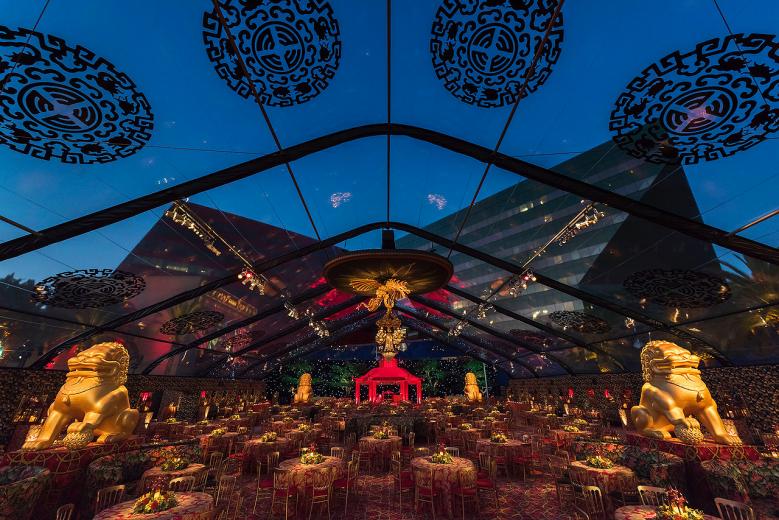1 10
"Grandeur" was an overriding theme of the 69th Primetime Emmy Awards after-parties. This gave longtime HBO designer Billy Butchkavitz the opportunity to create a look that paid homage to the Royal Pavilion palace in England and the interior design style of chinoiserie--a blend of Asian and European decorative arts.
As night fell, lighting further defined the environment’s main design elements--the gold lions, the pagoda and a central dragon chandelier. The venue: The Pacific Design Center in West Hollywood. Agile Eye Solutions created the large-scale decor pieces, pagoda, custom tent skin embellishments, and the step-and-repeat.
Prep for the Sept. 17 party started a full week earlier. Here, subflooring and tenting are going in over the fountain at the Pacific Design Center. Town and Country Event Rentals provided the custom tent, carpeting and rentals.
Getting closer to the day of the event with the pagodas installed. Special Event Contractors installed the elevated subfloors, perimeter walls, elevated walkways, and decorative railings.
A pond going across the space was outfitted with 16-foot-long bridges designed in the style consistent with the chinoiserie elements of the Royal Pavilion, which inspired the look.
The main 30-foot diameter pagoda was also an entertainment hub. The dramatic lighting was provided by Images by Lighting, with projections handled by Bart Kresa Design.
A combination of textiles and patterns captures the style Butchkavitz was honoring.
Tabletop details brought the design down to eye level.
Larger-than-life elements--such as these 12-foot-high guardian lions--kept guests looking up. Note more textures, more patterns upon patterns. Even lighting projections added another layer to the look.
The ultimate reason the guests looked up: a 20-foot-long dragon holding a sparkling, intricate chandelier. A replica of the one that illuminates the Royal Pavilion’s banquet room, it was given center stage in the massive tent. With details such as this, it’s no wonder that the magnificent English palace has remained in Butchkavitz’s imagination for 30 years.

